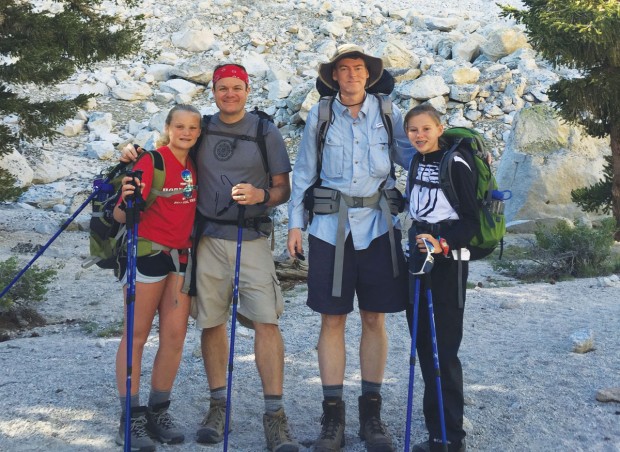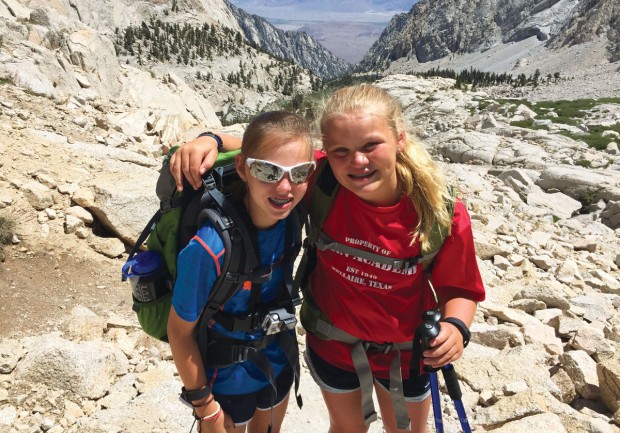Father-daughter mountain climb


Reagan Kimzey, Shane Kimzey, Hal Means and Charlotte Means (from left) take a break from their father-daughter climb of Mt. Whitney to catch their breaths and a few memories.
Boy Scouts and Girl Scouts may leave their badges, hats and uniforms behind along with their graduation caps, but the spirit and the skills last a lifetime, as Hal Means and Shane Kimzey would be quick to tell you. These two very grown-up Boy Scouts had taken their sons, James and Christopher, on Scouting expeditions, but this summer, the tales they brought back from a father-daughter expedition were enough to bring out the Scout in anyone.
Hal, a marketing professional, and Shane, a house attorney at CenterPoint Energy, found that their Scout training came in handy when their daughters decided they wanted to climb some of the world’s highest peaks.
It all started when Charlotte Means, then a sixth grader at St. John’s School, was reading a book called No Summit Out of Sight, the true story of Jordan Romero, the youngest person to climb the seven highest peaks in the world. Means was so inspired that she proposed climbing Mount Everest – after all, Jordan Romero had done it when he was 13, she reasoned.
Hal was impressed with his daughter’s initiative but proposed starting with a peak a bit closer to home: Mount Whitney in California, the highest peak in the lower 48 United States. It turned out Charlotte’s brother Christopher, also a Boy Scout, and mother Aline were otherwise occupied for the days they had a permit to climb Mount Whitney, so she asked if she could invite friend and neighbor Reagan Kimzey, then a seventh grader at Pershing Middle School, and her father Shane. That’s how the idea for the father-daughter trek was born.
Training for high-mountain climbing in the flatlands of Houston was no easy feat. They settled on the Ho Chi Minh Trail in Memorial Park, a mountain biking trail with plentiful ups and downs, stadium stairs, and the hill surrounding the Miller Outdoor Theatre. They also enjoyed the Japanese garden near the theater – “It was really pretty and it kind of reminded us of hiking at Mount Whitney,” Charlotte said later.
Shane and Hal, both Eagle Scouts, already had abundant gear; Shane had climbed Kilimanjaro several years ago. They borrowed hiking poles from a friend to help with the steep climbing and the descent, and they stocked up on moleskin and other first-aid supplies, iodine tablets for the water, rain gear and other incidentals.
“We each got a good pair of boots, and everyone broke in their boots really well before the trip so there would be no blisters,” said Hal.
The fathers and daughters got to the trailhead and began hiking at 5:30 a.m. “It was pretty dark, and it was cold,” recalled Reagan. “When the sun started coming up you could see the sunrise through the mountains, and that was pretty cool.”
They climbed under a steadily rising sun, coming to a pretty, green valley blooming with wildflowers with a clear stream running through it and a waterfall.
“The landscape was like Narnia meets Lord of the Rings,” said Hal.
Mt. Whitney’s western slope lies in Inyo National Forest, and the trekkers marveled at the giant Sequoias, some of the largest trees in America. Deer, chipmunks and an abundance of birds made their appearance. The girls were particularly charmed by the enormous, notched, log bridge that crossed a swampy area – “they were like human Lincoln logs,” commented Charlotte.

Charlotte Means (at left) and Reagan Kimzey take a break above the treeline on the Mt. Whitney Trail, happy and proud of their progress.
They made steady progress throughout the morning, climbing switchback after switchback. Despite their good athletic condition – Reagan and Charlotte are both competitive swimmers – the altitude began to take a toll.
“When we got to 11,000 feet, the altitude started really getting to us,” said Reagan. “I didn’t think I was going to be able to go on. I was not being able to focus, and my head was really hurting.”
They sat down and ate lunch somewhere between the 11,000 and 12,000 mark, and Hal was suffering as well. “I was feeling nausea, dizziness, and a headache – it was pretty bad. I had felt it a little earlier but you just rest, drink water, eat a little bit and keep going. There was a point I was so dizzy I had to stop, because I didn’t want to fall.”
The other three continued and were closing in on the 12,000 mark when they decided it was time to turn back.
“It turned out to be a bit farther than we thought,” said Shane. “We finally realized it would be too far to get there and back in one day. It just wasn’t in the cards for that day. For safety’s sake and practicality, we decided that was far enough…. Mountain climbers have a saying: ‘Going up is optional, coming down isn’t.’”
Reagan was the one who took it the hardest. “It was really frustrating,” she said. “We thought we only had 3 miles to go, and then we found out it was 5 miles. We thought we’d come so far when we hadn’t.”
Shane was quick to put things into perspective. “The girls climbed higher and farther than they’d ever climbed before,” he said. “For their ages, it was incredibly amazing.”
The girls had barely made it down before they began planning their return. “We know now where the campgrounds are and where to start out and what time,” said Reagan. “I think we could do it if we took two days. We all want to go to other mountains, too; instead of making us not want to do it, it made us want to do it even more.”
The trip included a drive through Death Valley, 282 feet below sea level, at the opposite extreme from Mount Whitney. “We got contrasts that were astounding,” said Hal.
The group learned not to count on technology; cell phone apps to measure altitude and distance don’t necessarily work at that altitude, and they agreed it’s better to rely on good old-fashioned maps and compasses and know-how from guidebooks.
Reagan, who has asthma, knew that training was key, but so was attitude. “You have to know what you’re up against; you have to train and do what’s required. But you also have to know that you can do it,” she said. “I learned a lot about myself on this trip – I learned I can do a lot more than I thought I could.”
Charlotte agreed. “It was an amazing experience – and like Mr. Kimzey said, it’s not the destination, it’s the journey.”
“I agree,” chimed in Reagan. “We had some fun – and we learned that you don’t have to make it to the top to succeed.”
Editor’s note: See Travel Buzz writer Tracy Barnett’s account of a local Boy Scout troop’s challenging trek in New Mexico.
Gearing Up - Be Prepared
Most Scouts would agree that selecting the right gear is an important part of being prepared. For the Kimzeys and the Means, REI was a good starting point – both the store and the website. Here are their tips:
BOOTS: Hal, Charlotte, and Shane all got theirs at REI: Lowas (Hal), Salomons (Charlotte) and Garmonts (Shane – they survived Kilimanjaro, Mt. Washington in New Hampshire and Mt. Whitney among others). Reagan’s were Columbias from Academy (so a bit cheaper, but they did the job). The key is to get boots that are comfortable, provide good ankle support, are not too heavy, have plenty of extra space at the end of the toe box (extremely important when descending!) and are well-broken in. It also helps if they’re waterproof, as Hal discovered when he slipped into one of the icy streams and submerged a foot. Extra socks are a must.
POLES: Adjustable trekking poles are extremely helpful.
PACK: A good-sized day pack to carry plenty of water, food, first aid kit, rain gear, and cold weather gear. Some people like to have insect repellent, as well.
PLUS: On Mount Whitney, you had to have a “wag bag” – something the National Park Service provides for you to hike out solid human waste.
Shane also shared the “Classic 10 Essentials” for hiking from REI.com – the classic version, plus the updated version. The original 10 Essentials list was compiled in the 1930s by The Mountaineers, a Seattle-based climbers’ group. In 2003, the group updated the list to a “systems” approach rather than listing individual items (for example, map and compass now fall into the Navigation “system.”)
Classic Ten Essentials
1. Map
2. Compass
3. Sunglasses and sunscreen
4. Extra clothing
5. Headlamp/flashlight
6. First-aid supplies
7. Firestarter
8. Matches
9. Knife
10. Extra food
Updated Ten Essential “Systems”
1. Navigation (map and compass)
2. Sun protection (sunglasses and sunscreen)
3. Insulation (extra clothing)
4. Illumination (headlamp/flashlight)
5. First-aid supplies
6. Fire (waterproof matches/lighter/candles)
7. Repair kit and tools
8. Nutrition (extra food)
9. Hydration (extra water)
10. Emergency shelter
Climb for Life
As part of this journey, Charlotte created a GoFundMe campaign named "Climb for Life" to raise funds for a charity that provides temporary housing for families with a pediatric cancer patient. She was a schoolmate of a boy who passed away from cancer. Her goal was to raise $1,000, and donations totaled $1,345. You can find out more at https://www.gofundme.com/climbforlife.
Want more buzz like this? Sign up for our Morning Buzz emails.
To leave a comment, please log in or create an account with The Buzz Magazines, Disqus, Facebook, or Twitter. Or you may post as a guest.


